 |
||
|
||
| ||
Do we really need a new processor? Sure, there are tasks which can load entirely an N-GHz Pentium M, but they are far from an ordinary user. The difference in the Word is almost unnoticeable. In games a GPU, which now integrates sound, will probably soon be able to calculate physics, thus, making a CPU the last think to consider. But I think far are these days when poor processors will be completely thrown away. And now let's see what the new Pentium 4 can offer... New Pentium 4 "Northwood" coreFirst of all, let's take a look at this core and its predecessor:  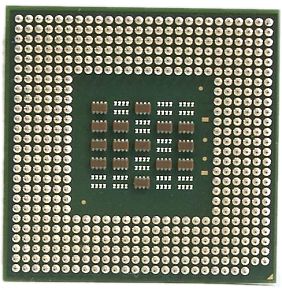 Intel Pentium 4 "Northwood", 2.2 GHz, Socket 478  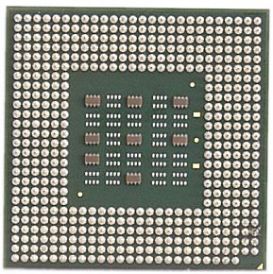 Intel Pentium 4 "Willamette", 2 GHz, Socket 478 Look at the lower line: 512 KBytes L2 cache is the only architectural difference from the old processor which had a 256 KBytes one. It became possible as Intel made a transition to the 0.13micron technology with copper interconnects. As a result, a 200mm plate now can house twice more dies than with the 0.18 technology. (Further, 300mm plates will be able to contain 2.5 more of them.) This fab process will allow for a higher frequency of processors and decreased power consumption (49.8 W TDP of the 2.2 GHz Northwood version against 75 W of the Willamette 2 GHz). The processor on the new core contains 55 million transistors (of 146 mm2), almost 40% of which are meant for the cache (the Willamette has 42 million of them, and it is only an L2 size that changed). 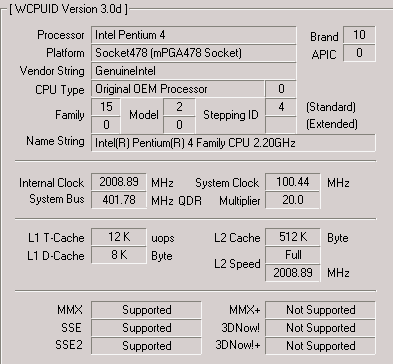 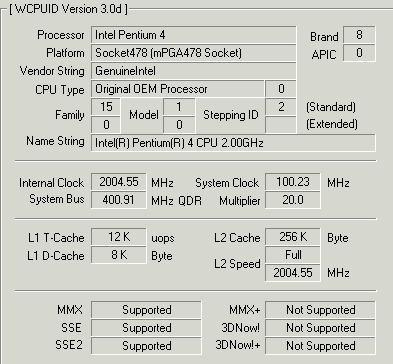 The new core needs a new CPU load line, but here must be no problems as all mainboards for the Socket 478 were developed with the new processors in mind, and their current VRM supports such line; that is why the worst thing you might have to do is to flash a new BIOS. A 2 GHz processor will be the last in the Willamette line and the first in the Northwood one, that is why to distinguish them Intel uses index "A": the Northwood processor will be named Intel Pentium 4 2A GHz. PerformanceTest system configuration:
Software:
It should be noted that there are two more participants. First of all, the Northwood was tested at 2 GHz, for what we decreased its CPU multiplier. Thus, we got an opportunity to find out a net profit from the increased L2 cache. Secondly, the Willamette 2 GHz was overclocked to 2.2 GHz via the bus (110 MHz x 20). It allows us to clarify what's better - a larger cache or a faster bus, and to make some estimations for the future as the Pentium 4's bus will soon be clocked at 133 MHz (533 MHz Quad-Pumped). We'll kick it off with a look at encoding and archiving. Test results: MP3 encoding with the Lame is not very memory dependent. Here you can see a 3-4% gain due to a larger cache of the Northwood and a good increase (~10%) at the expense of the processor frequency. The accelerated bus provides some performance gain, but the absolute difference in the results is too little.  It is interesting that the new version of the DivX codec optimized for the SSE2 allows for a 30-40% gain! The Northwood edges out the old processor by 7-9% at the expense of a 10% higher speed, while the advantage of the overclocked Willamette is more significant: 10-15%. The increased cache of the Northwood allows for a tad higher performance, but this effect is smoothed over by the increased bus speed (which accelerates the L2 cache as well). By the way, with the SSE2 enabled the difference is deeper in all cases. 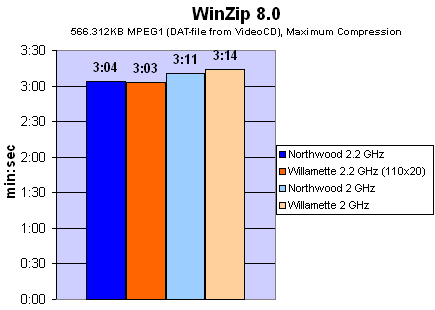 The WinZip results remind us the MP3 encoding both in the numbers and in the character of dependence. The difference of a couple of seconds is not much revealing.  The WinAce results are very similar to those of the MPEG4 coding " both tests work aggressively with memory, but the WinAce often addresses to the dictionary which allows for a 8% gain for the Northwood processor. If the whole 4 MBytes dictionary fitted the cache the acceleration might be very significant. The test doesn't benefit much from the increased CPU speed because it mostly memory dependent.  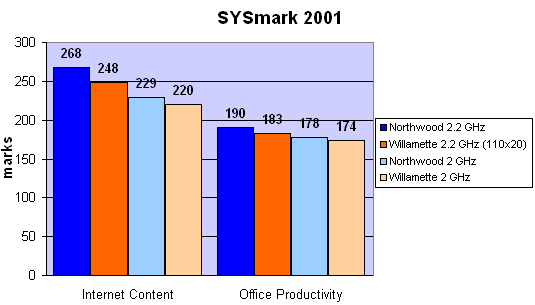 Well, the situation is very similar in both semisynthetic tests, though the 2.2 GHz Northwood has a greater margin over the overclocked Willamette than the 2 GHz one in equal conditions. 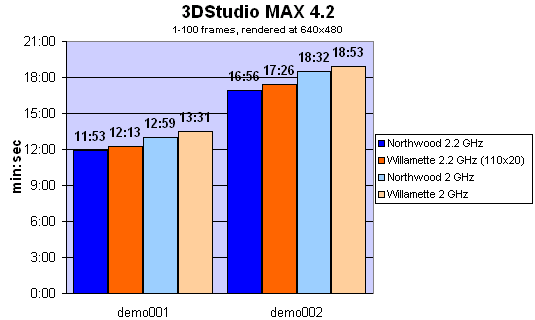 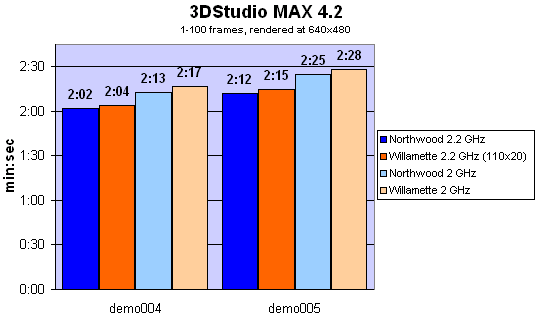 The description of the scenes for the 3DStudio MAX can be found in our introduction to the testing of the professional video cards. The computational character is the same regardless of complexity of scene calculation by the processor and complexity of scene drawing by a GPU; and the calculation is accelerated equally for all scenes: by ~9% with the increased CPU speed and by ~3% at the expense of the larger cache; the faster bus doesn't boost up the performance much. As you can see, it is a computational test, and it is mainly CPU dependent. 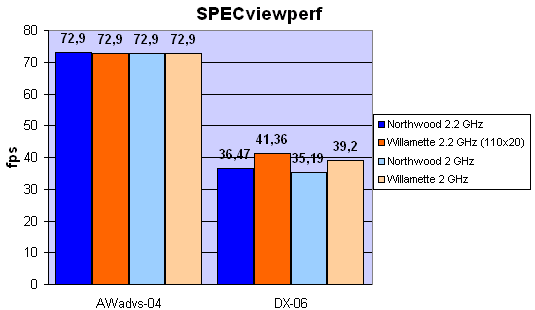 The AWadvs-04 as always limits a scene drawing speed by the video accelerator speed. But it is interesting that in the DX-06 the increased cache adversely affects the memory exchange speed. So, if you are going to work primarily with the IBM Data Explorer the Northwood won't suit you. 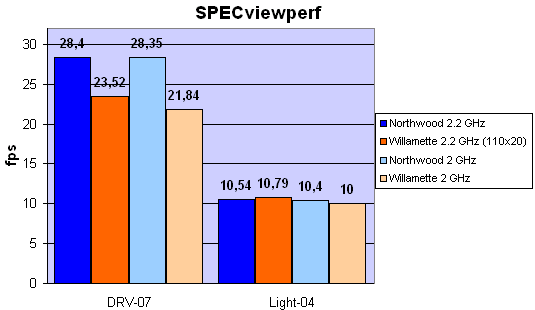 In the DRV-07 the system has almost no boost from the higher frequency, while the bus speed has a strong effect on the scores (or it's rather the memory-AGP link). But this 8% gain is nothing as compared with 30% of the 512K L2 Northwood gained over the 256K L2 Willamette. In the Light-04 the situation is very similar to the previous one, just without a sharp rise of the Northwood; the overclocked AGP bus of the Willamette 2.2 GHz makes it the leader as the GPU performance matters most of all. 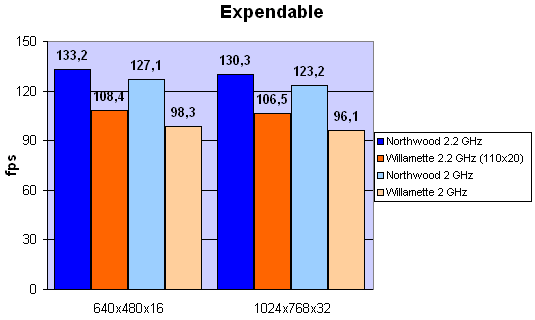 Well, now I can state that that mysterious rise was caused by the RDRAM. As you know, Expendable is a game with a chaotic algorithm which gives bad headache to the long pipeline of the Pentium 4 and annoys the RDRAM with its long latency by jumping all over the memory. The increased cache of the Northwood smoothes it away. By the way, the DDR SDRAM would make this artifact less noticeable that is why only fans of the Expendable and Rambus could enjoy such a magic acceleration. It is also worth noting that the bus acceleration speeds up not a video accelerator but a processor-memory link.  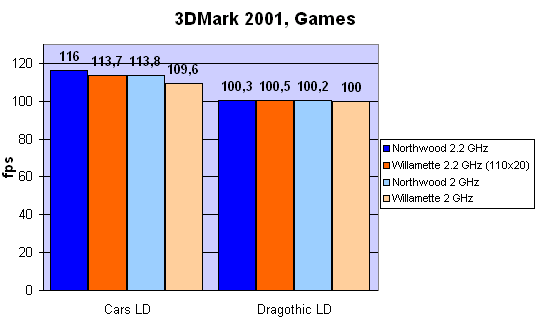  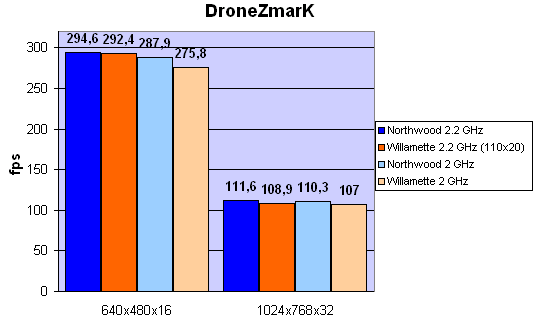 All modern games show the same: the Northwood gets a 5% lead at the expense of the larger cache which drops down to 1-2% with the overclocked bus of the Willamette. But it is so only for those tests and resolutions where the overall performance mainly depends on a CPU. ConclusionWell, the new processor has one but feasible advantage over the old one. On the one hand, there is a very small advantage in encoding with the DivX v4.02 and a performance drop in the DX-06, but on the other hand we have a 30% gain in operation with RDRAM. On average, we have a 5-8% lead, though in pure processor tasks it can be even greater. But it is not good to compare the old and the new cores as they will never cross each other in the Pentium 4 line (or just one time, and the comparative results are in front of you). The prospects are quite promising: in the tests of operation of the processor and memory we get 10-15% gain for the 10% accelerated bus. We won't take into account an advantage in graphics applications as AGP and PCI frequencies of boards with a future 133 MHz processor will be probably OK, while the Pentium 4 and the DDR266 working synchronously at 133 MHz look quite attractive, according to the results of the Willamette 2.2 GHz. So, what is the new processor for?
Write a comment below. No registration needed!
|
Platform · Video · Multimedia · Mobile · Other || About us & Privacy policy · Twitter · Facebook Copyright © Byrds Research & Publishing, Ltd., 1997–2011. All rights reserved. |